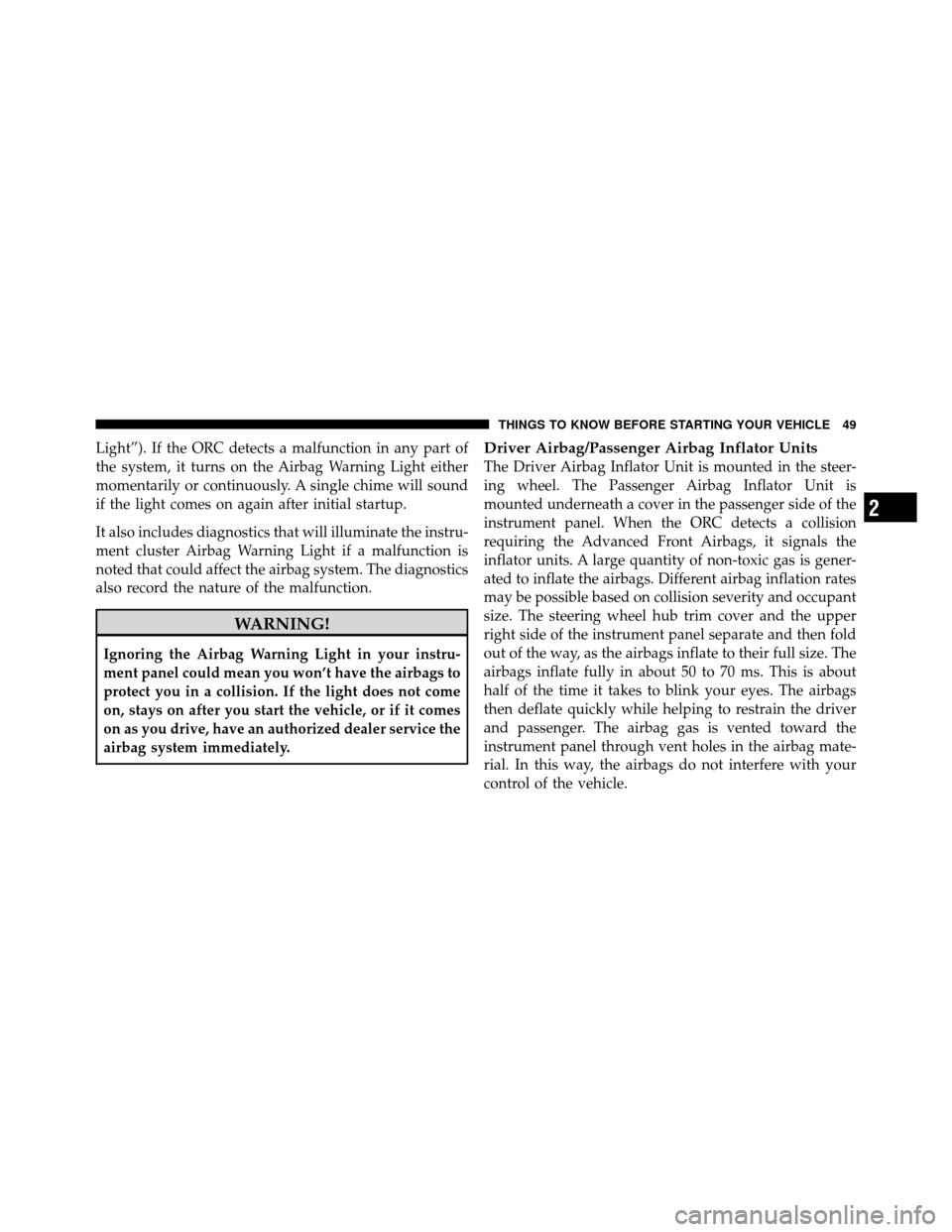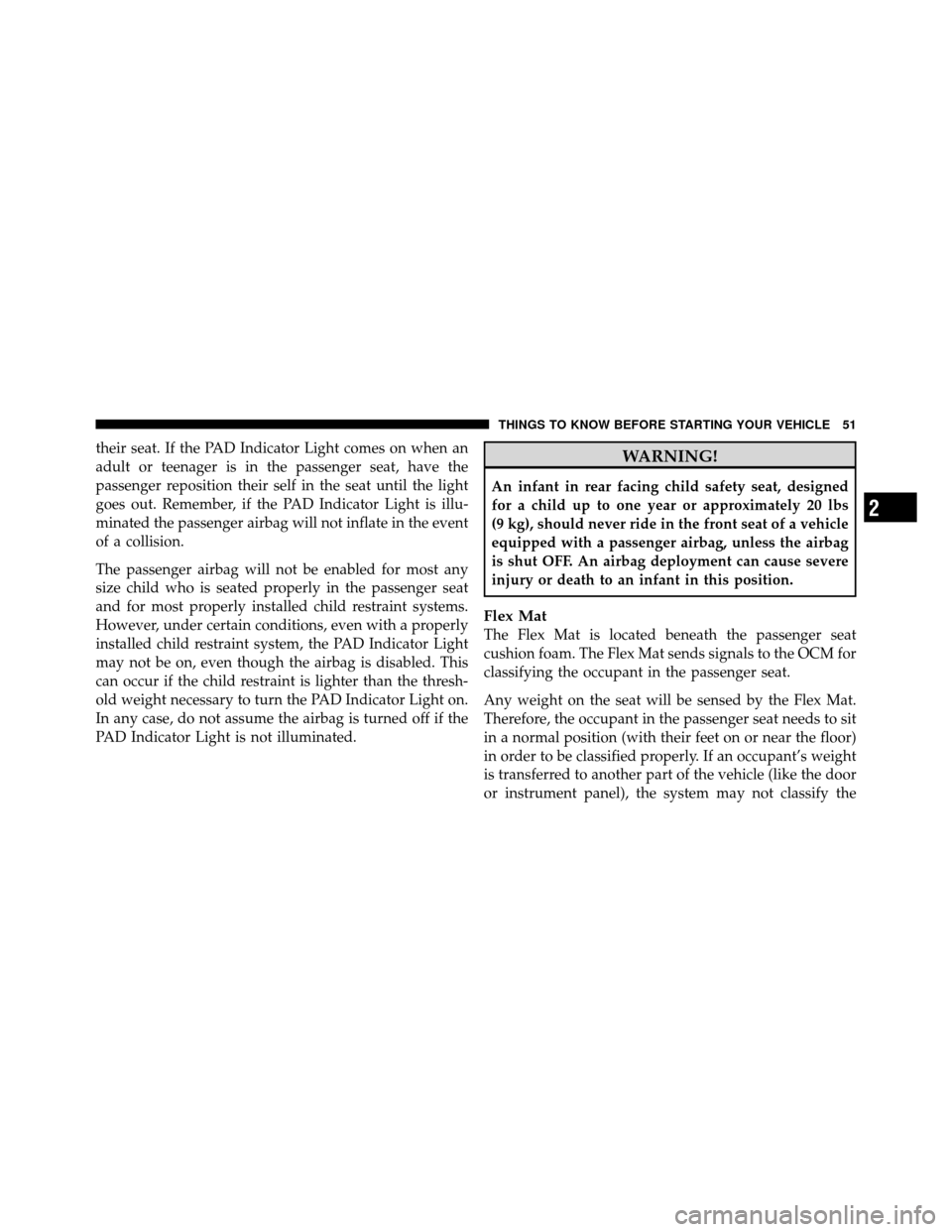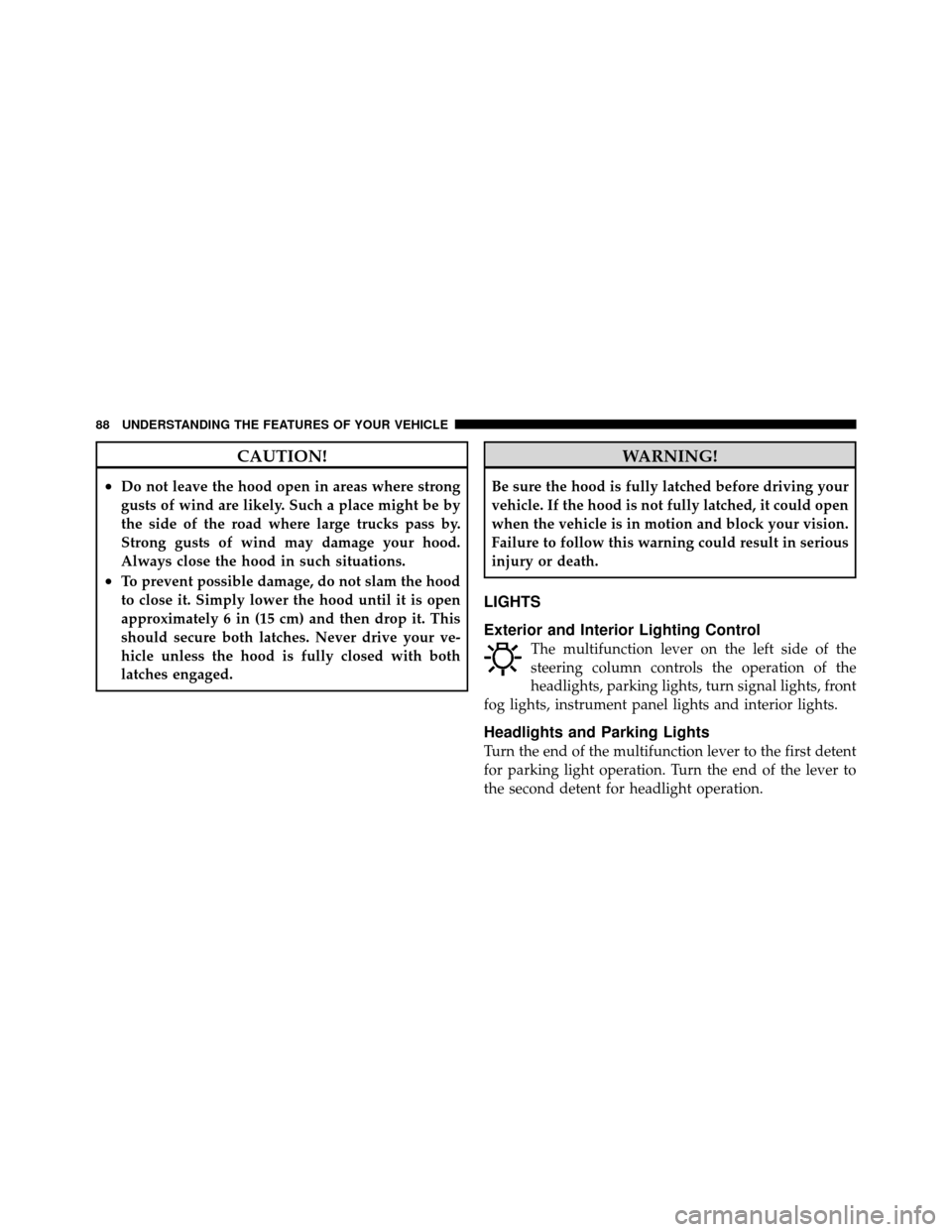Page 53 of 315

Light”). If the ORC detects a malfunction in any part of
the system, it turns on the Airbag Warning Light either
momentarily or continuously. A single chime will sound
if the light comes on again after initial startup.
It also includes diagnostics that will illuminate the instru-
ment cluster Airbag Warning Light if a malfunction is
noted that could affect the airbag system. The diagnostics
also record the nature of the malfunction.
WARNING!
Ignoring the Airbag Warning Light in your instru-
ment panel could mean you won’t have the airbags to
protect you in a collision. If the light does not come
on, stays on after you start the vehicle, or if it comes
on as you drive, have an authorized dealer service the
airbag system immediately.
Driver Airbag/Passenger Airbag Inflator Units
The Driver Airbag Inflator Unit is mounted in the steer-
ing wheel. The Passenger Airbag Inflator Unit is
mounted underneath a cover in the passenger side of the
instrument panel. When the ORC detects a collision
requiring the Advanced Front Airbags, it signals the
inflator units. A large quantity of non-toxic gas is gener-
ated to inflate the airbags. Different airbag inflation rates
may be possible based on collision severity and occupant
size. The steering wheel hub trim cover and the upper
right side of the instrument panel separate and then fold
out of the way, as the airbags inflate to their full size. The
airbags inflate fully in about 50 to 70 ms. This is about
half of the time it takes to blink your eyes. The airbags
then deflate quickly while helping to restrain the driver
and passenger. The airbag gas is vented toward the
instrument panel through vent holes in the airbag mate-
rial. In this way, the airbags do not interfere with your
control of the vehicle.
2
THINGS TO KNOW BEFORE STARTING YOUR VEHICLE 49
Page 55 of 315

their seat. If the PAD Indicator Light comes on when an
adult or teenager is in the passenger seat, have the
passenger reposition their self in the seat until the light
goes out. Remember, if the PAD Indicator Light is illu-
minated the passenger airbag will not inflate in the event
of a collision.
The passenger airbag will not be enabled for most any
size child who is seated properly in the passenger seat
and for most properly installed child restraint systems.
However, under certain conditions, even with a properly
installed child restraint system, the PAD Indicator Light
may not be on, even though the airbag is disabled. This
can occur if the child restraint is lighter than the thresh-
old weight necessary to turn the PAD Indicator Light on.
In any case, do not assume the airbag is turned off if the
PAD Indicator Light is not illuminated.WARNING!
An infant in rear facing child safety seat, designed
for a child up to one year or approximately 20 lbs
(9 kg), should never ride in the front seat of a vehicle
equipped with a passenger airbag, unless the airbag
is shut OFF. An airbag deployment can cause severe
injury or death to an infant in this position.
Flex Mat
The Flex Mat is located beneath the passenger seat
cushion foam. The Flex Mat sends signals to the OCM for
classifying the occupant in the passenger seat.
Any weight on the seat will be sensed by the Flex Mat.
Therefore, the occupant in the passenger seat needs to sit
in a normal position (with their feet on or near the floor)
in order to be classified properly. If an occupant’s weight
is transferred to another part of the vehicle (like the door
or instrument panel), the system may not classify the
2
THINGS TO KNOW BEFORE STARTING YOUR VEHICLE 51
Page 71 of 315

WARNING! (Continued)
•Always make sure that objects cannot fall into the
driver foot well while the vehicle is moving.
Objects can become trapped under the brake pedal
and accelerator pedal causing a loss of vehicle
control.
•If required, mounting posts must be properly
installed, if not equipped from the factory.
Failure to properly follow floor mat installation or
mounting can cause interference with the brake
pedal and accelerator pedal operation causing loss
of control of the vehicle.
Periodic Safety Checks You Should Make Outside
the Vehicle
Tires
Examine tires for excessive tread wear and uneven wear
patterns. Check for stones, nails, glass, or other objectslodged in the tread. Inspect the tread and sidewall for
cuts and cracks. Check the wheel nuts for tightness.
Check the tires (including spare) for proper pressure.
Lights
Have someone observe the operation of exterior lights
while you work the controls. Check turn signal and high
beam indicator lights on the instrument panel.
Door Latches
Check for positive closing, latching, and locking.
Fluid Leaks
Check area under vehicle after overnight parking for fuel,
engine coolant, oil, or other fluid leaks. Also, if gasoline
fumes are detected or if fuel, power steering fluid, or
brake fluid leaks are suspected, the cause should be
located and corrected immediately.
2
THINGS TO KNOW BEFORE STARTING YOUR VEHICLE 67
Page 74 of 315
▫Lights-On Reminder ................... 90
▫ Battery Saver Feature — Exterior Lights ..... 90
▫ Fog Lights .......................... 90
▫ Turn Signals ......................... 91
▫ High Beam/Low Beam Select Switch ....... 91
▫ Flash-To-Pass ........................ 91
▫ Interior Lights ....................... 91
� Windshield Wipers And Washers ........... 94
▫ Intermittent Wiper System ............... 95
▫ Mist Feature ......................... 96 ▫
Windshield Washers ................... 96
� Tilt Steering Column .................... 96
� Adjustable Pedals ...................... 97
▫ Adjustable Foot Rest ................... 99
� Electrical Power Outlets ................. 100
� Console Features ...................... 102
� Storage ............................. 103
� Rear Window Features .................. 104
▫ Rear Window Defroster ................ 104
70 UNDERSTANDING THE FEATURES OF YOUR VEHICLE
Page 92 of 315

CAUTION!
•Do not leave the hood open in areas where strong
gusts of wind are likely. Such a place might be by
the side of the road where large trucks pass by.
Strong gusts of wind may damage your hood.
Always close the hood in such situations.
•To prevent possible damage, do not slam the hood
to close it. Simply lower the hood until it is open
approximately 6 in (15 cm) and then drop it. This
should secure both latches. Never drive your ve-
hicle unless the hood is fully closed with both
latches engaged.
WARNING!
Be sure the hood is fully latched before driving your
vehicle. If the hood is not fully latched, it could open
when the vehicle is in motion and block your vision.
Failure to follow this warning could result in serious
injury or death.
LIGHTS
Exterior and Interior Lighting Control
The multifunction lever on the left side of the
steering column controls the operation of the
headlights, parking lights, turn signal lights, front
fog lights, instrument panel lights and interior lights.
Headlights and Parking Lights
Turn the end of the multifunction lever to the first detent
for parking light operation. Turn the end of the lever to
the second detent for headlight operation.
88 UNDERSTANDING THE FEATURES OF YOUR VEHICLE
Page 95 of 315

Turn Signals
Move the multifunction lever upward or downward and
the corresponding turn signal indicator on the instru-
ment panel will flash to show proper operation of the
front and rear turn signal lights.NOTE:
If either light has a very fast flash rate, check for
a defective outside light bulb. If an indicator fails to light
when the lever is moved, it would suggest that the
indicator bulb is defective.
High Beam/Low Beam Select Switch
Pull the multifunction lever toward you to switch the
headlights to high beam. Pull the lever a second time to
switch the headlights back to low beam.
Flash-to-Pass
You can signal another vehicle with your headlights by
lightly pulling the multifunction lever toward you. This
will turn on the high beam headlights until the lever is
released.
Interior Lights
The interior lights will turn on whenever a door is
opened or the liftgate is opened (Coupe models) and the
dimmer switch is not in the defeat position.
Turn Signal Operation
3
UNDERSTANDING THE FEATURES OF YOUR VEHICLE 91
Page 115 of 315

does not come on when turning the key from OFF/LOCK
to ON/RUN, have the condition checked promptly.
Certain conditions such as a loose or missing gas cap,
poor fuel quality, etc., may illuminate the light after
engine start. The vehicle should be serviced if the light
remains on through several of your typical driving
cycles. In most situations, the vehicle will drive normally
and will not require towing.
CAUTION!
Prolonged driving with the MIL on could cause
damage to the engine control system. It also could
affect fuel economy and drivability. If the MIL is
flashing, severe catalytic converter damage and
power loss will soon occur. Immediate service is
required.
WARNING!
A malfunctioning catalytic converter, as referenced
above, can reach higher temperatures than in normal
operating conditions. This can cause a fire if you
drive slowly or park over flammable substances such
as dry plants or wood or cardboard, etc. This could
result in death or serious injury to the driver, occu-
pants or others.
Turn Signal Indicators
The left or right arrow will flash in unison with the
corresponding front and rear turn signals when the
TURN SIGNAL switch is operated.
Hazard Indicators
Both turn signal arrows will flash in unison with the
front and rear turn signals when the HAZARD
WARNING button is operated.
4
UNDERSTANDING YOUR INSTRUMENT PANEL 111
Page 164 of 315
WARNING! (Continued)
•The ABS cannot prevent the natural laws of phys-
ics from acting on the vehicle, nor can it increase
braking or steering efficiency beyond that af-
forded by the condition of the vehicle brakes and
tires or the traction afforded.
•The ABS cannot prevent accidents, including
those resulting from excessive speed in turns,
following another vehicle too closely, or hydro-
planing.
•The capabilities of an ABS equipped vehicle must
never be exploited in a reckless or dangerous
manner, which could jeopardize the user’s safety
or the safety of others.All vehicle wheels and tires must be the same size and
type as the original equipment and the tires must be
properly inflated to produce accurate signals for the
computer.
WARNING!
Significant over or under-inflation of tires, or mixing
sizes of front or rear tires or wheels on the vehicle can
lead to loss of braking effectiveness.
160 STARTING AND OPERATING